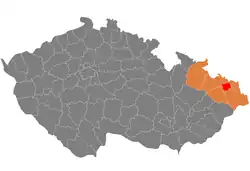Ostrava-City District
Ostrava-City District (Czech: okres Ostrava-město) is a district in the Moravian-Silesian Region of the Czech Republic. Its capital is the city of Ostrava.
Ostrava-City District
Okres Ostrava-město | |
|---|---|
 Location in the Moravian-Silesian Region within the Czech Republic | |
| Coordinates: 49°39′N 18°1′E | |
| Country | |
| Region | Moravian-Silesian |
| Capital | Ostrava |
| Area | |
| • Total | 331.53 km2 (128.00 sq mi) |
| Population (2023)[2] | |
| • Total | 316,149 |
| • Density | 950/km2 (2,500/sq mi) |
| Time zone | UTC+1 (CET) |
| • Summer (DST) | UTC+2 (CEST) |
| Municipalities | 13 |
| * Cities and towns | 4 |
| * Market towns | 0 |
Administrative division
Ostrava-City District is formed by only one administrative district of municipality with extended competence: Ostrava.
List of municipalities
Cities and towns are marked in bold:
Čavisov – Dolní Lhota – Horní Lhota – Klimkovice – Olbramice – Ostrava – Šenov – Stará Ves nad Ondřejnicí – Václavovice – Velká Polom – Vratimov – Vřesina – Zbyslavice
Geography

The terrain is mostly flat and in the west slightly undulating, without significant hills. The territory extends into four geomorphological mesoregions: Ostrava Basin (east and centre), Nízký Jeseník (west), Moravian Gate (southwest), and Opava Hilly Land (negligible part in the north). The highest point of the district is the hill Úhorky in Horní Lhota with an elevation of 404 m (1,325 ft). The lowest point of the district is the river bed of the Oder in Ostrava-Antošovice at 199 m (653 ft).
From the total district area of 331.5 km2 (128.0 sq mi), agricultural land occupies 152.8 km2 (59.0 sq mi), forests occupy 54.0 km2 (20.8 sq mi), and water area occupies 11.7 km2 (4.5 sq mi). Forests cover 16.3% of the district's area.[1]
The most important river of the district is the Oder, which flows across the territory from south to north. The Opava River flows into the Oder from the west. The largest body of water is Heřmanický Pond with an area of 116 ha (290 acres).[3]
A part of the territory along the Oder River is protected as the Poodří Protected Landscape Area.
Demographics
|
|
| ||||||||||||||||||||||||||||||||||||||||||||||||||||||
| Source: Censuses[4][5] | ||||||||||||||||||||||||||||||||||||||||||||||||||||||||
Most populated municipalities
| Name | Population[2] | Area (km2) |
|---|---|---|
| Ostrava | 283,504 | 214 |
| Vratimov | 7,336 | 14 |
| Šenov | 6,553 | 17 |
| Klimkovice | 4,516 | 15 |
| Stará Ves nad Ondřejnicí | 2,936 | 19 |
| Vřesina | 2,865 | 9 |
Economy
Ostrava is the economic centre of the entire Moravian-Silesian Region. With only one exception, all the largest employers with headquarters in Ostrava-City District and at least 1,000 employees have their seat in Ostrava. The largest employers with headquarters in Ostrava and at least 1,500 employees are:[6]
| Economic entity | Number of employees | Main activity |
|---|---|---|
| Liberty Ostrava | 5,000–9,999 | Manufacture of iron and steel |
| Faculty Hospital Ostrava | 4,000–4,999 | Health care |
| Regional Police Directorate of the Moravian-Silesian Region | 4,000–4,999 | Public administration |
| City of Ostrava | 3,000–3,999 | Public administration |
| DHL Solutions | 3,000–3,999 | Warehousing and storage |
| Hruška | 3,000–3,999 | Retail sale |
| VSB – Technical University of Ostrava | 2,500–2,999 | Education |
| City Hospital Ostrava | 2,000–2,499 | Health care |
| Dopravní podnik Ostrava | 2,000–2,499 | Public transport |
| Tietoevry Connect Czechia | 1,500–1,999 | Computer programming and consultancy |
| University of Ostrava | 1,500–1,999 | Education |
The largest company based in the district, but outside Ostrava, is KES – kabelové a elektrické systémy, a manufacturer of electrical equipment for motor vehicles with 1,000–1,499 employees.[6]
Transport
The D1 motorway from Brno to the Czech-Polish passes through the district. There is also the D56 motorway, which connects Ostrava with Frýdek-Místek.
Sights

The most important monuments in the district, protected as national cultural monuments, are:[7]
- Red Army Monument in Ostrava
- Michal Mine in Ostrava
- Hlubina Mine and Vítkovické železárny's high furnace and coke oven in Ostrava
- Liska's villa in Ostrava
The best-preserved settlements, protected as monument zones, are:[8]
- Ostrava-Moravská Ostrava
- Ostrava-Poruba
- Ostrava-Přívoz
- Ostrava-Vítkovice
Four of the ten most visited tourist destinations of the Moravian-Silesian Region are located in Ostrava. The most visited tourist destinations are Lower Vítkovice, Ostrava Zoo, Landek Park Ostrava mining museum, and Silesian Ostrava Castle.[9]
Notable people
References
- "Land use (as at 31 December)". Public database. Czech Statistical Office. Retrieved 2023-05-19.
- "Population of Municipalities – 1 January 2023". Czech Statistical Office. 2023-05-23.
- "Naučná stezka Heřmanický rybník" (in Czech). City of Ostrava. Retrieved 2023-04-22.
- "Historický lexikon obcí České republiky 1869–2011 – Okres Ostrava-město" (in Czech). Czech Statistical Office. 2015-12-21. pp. 1–2.
- "Population Census 2021: Population by sex". Public Database. Czech Statistical Office. 2021-03-27.
- "Registr ekonomických subjektů". Business Register (in Czech). Czech Statistical Office. Retrieved 2023-04-19.
- "Výsledky vyhledávání: Národní kulturní památky, okres Ostrava-město". Ústřední seznam kulturních památek (in Czech). National Heritage Institute. Retrieved 2023-04-19.
- "Výsledky vyhledávání: Památkové rezervace, Památkové zóny, okres Ostrava-město". Ústřední seznam kulturních památek (in Czech). National Heritage Institute. Retrieved 2023-04-19.
- "Turisté mají v České republice nejraději zoologické zahrady, technické památky, koupání a Pražský hrad" (in Czech). CzechTourism. 2022-06-24. Retrieved 2023-04-19.
External links
- Ostrava-City District – profile on the Czech Statistical Office website